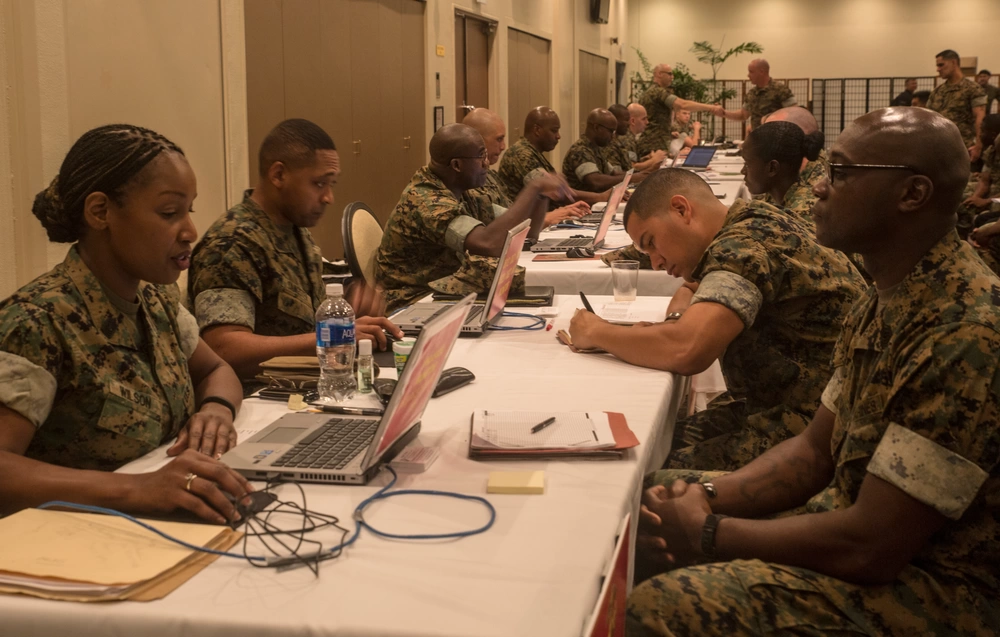
Behind the Orders: Demystifying Manpower Management
Posted on: March 31,2025“Hey, honey, we have orders.”
For Marine Corps families, those words evoke a mix of excitement, anxiety and anticipation. Whether you love or dread the idea of packing up and moving to a new duty station, one thing is certain: the process of receiving and managing orders is one of the most significant aspects of military life. But how does it all work? What goes on behind the scenes in the mysterious world of manpower management?
To shed light on this process, Major General Ryan S. “Chick” Rideout, Director of Manpower Management, and Sergeant Major Michael J. Exlos, his senior enlisted advisor, sat down for a candid discussion on the “Behind the Camouflage” podcast. Together, they addressed the myths, challenges and advancements in Marine Corps talent management and offered valuable insights for Marines and their families.
Regarding talent management: “It’s always going to be 51% needs of the Marine Corps,” MajGen Rideout explained. “But we’re leaning more and more into customer service. Under [Commandants] General Berger and now General Smith, we’ve moved away from viewing Marines as ‘inventory’ to recognizing them as individuals with unique needs and preferences.”

This shift reflects a broader change in philosophy: transitioning from a “recruit and replace” model to a “recruit and retain” approach. By focusing on retaining skilled personnel, the Marine Corps seeks to build a more experienced and cohesive force, encompassing active duty, reserves and civilian personnel.
For spouses, the assignment process can feel like a game of darts — random. The reality is, at its core, the assignment process balances the Corps’ needs, available positions and Marine preferences.
SgtMaj Exlos emphasized the importance of communication: “It’s all about having honest conversations—between the Marine, their spouse and their command. Planning early and sett ing clear personal and professional goals can make all the difference.”
The Corps has also improved the transparency of assignments, encouraging Marines to trust their monitors. “There are usually three stories,” said MajGen Rideout. “What the Marine tells their monitor, their spouse and their command. The goal is to get all those aligned.”
One of the most exciting developments is the Talent Management Engagement Portal (TMEP), a web-based system designed to help Marines and their families plan their careers. “This tool allows you to map out a career timeline, factoring in your kids’ ages, your spouse’s employment and other family needs,” said MajGen Rideout. “It’s a game changer.”
Currently in beta testing, TMEP enables Marines to make informed decisions about their next steps. The concept envisions a future version of TMEP integrating with other systems, streamlining PCS moves by automatically enrolling children in Child Development Centers or placing families on base housing lists. “With a little time and the proper funding, this could be reality in a year or two,” MajGen Rideout said.
Special Duty Assignments (SDAs) like recruiting, drill instructor duty and Marine Security Guard roles are critical for the Corps. These assignments can be challenging, but they also come with incentives.
“We’ve tied SDAs to duty station preferences and special pay,” said SgtMaj Exlos. “It’s about recognizing the sacrifices Marines and their families make.”
By increasing volunteer rates for SDAs through these incentives, the Marine Corps has reduced the need for involuntary assignments. “We’re now at over 70% volunteer rates,” MajGen Rideout noted. “That’s a huge improvement.”

In terms of retention, family considerations play a significant role. One notable policy change involves dual-active duty couples. “We’ve created a dedicated dual-military coordinator to ensure we keep families together,” said SgtMaj Exlos. “It’s now policy that separations require approval at the general officer level.”
The Marine Corps is also embracing “geo-stability,” allowing back-to-back tours in the same location when possible. This approach minimizes disruptions for families, particularly during critical times like a child’s senior year of high school.
We’re listening,” MajGen Rideout emphasized. “Policies like these are based on feedback from Marines and their families. We’re working to make their lives easier while still meeting the needs of the Corps.”
As the Marine Corps continues to in novate, tools like TMEP and family-focused policies are paving the way for a more predictable and satisfying career experience. MajGen Rideout and SgtMaj Exlos are optimistic about the future.
“We’re building a system that works for everyone,” said MajGen Rideout. “If you have ideas or feedback, we want to hear them. This is a team effort.”
For Marine Corps families, the road ahead looks brighter. With open communication, innovative tools and a commitment to retaining talent, the Corps is not just meeting its mission requirements—it’s creating a community where Marines and their families can thrive.
Check out the Behind the Camouflage Podcast MajGen Rideout here or search Behind the Camouflage on Spotify or iTunes!




